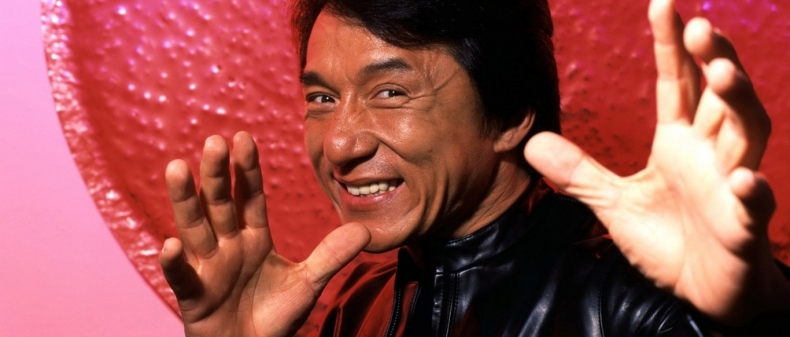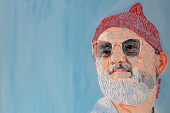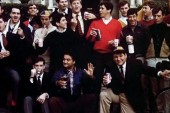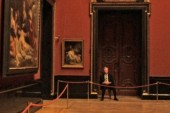
Jackie Chan approaches the English language with the same resourcefulness, energy, and vague sense of exhaustion as he stages his fight scenes. Like one of his on-screen heroes, who always seems a few steps behind the villain and must grasp whatever conveniently-placed props are available to fend off his four/five enemies, Chan races through stories grasping at words like so many beach chairs, umbrellas, or pool noodles.
At the TIFF Bell Lightbox, where he introduced four of his films this week to promote the “A Century of Chinese Cinema” retrospective, Chan variously swiveled in his chair, twisted his face, hopped on his feet, and (when the time called for it) simulated a swift kick in the groin to intensify his anecdotes. For a man who has broken seemingly every bone in his body over 59 years, such agility is fairly remarkable. Like so many kung-fu stars who rose to prominence in the ‘70s, Chan struggled to escape comparison to Bruce Lee; as a public speaker, his storytelling style might be more accurately likened to Jackson Pollack.
***
“When I was a stunt guy, Bruce Lee was a megastar,” says Chan. Fresh out of ten years of grueling training at the Peking Opera School, the young martial artist drifted into the Hong Kong film industry in the ‘60s and ‘70s, where he earned a reputation for performing stunts so dangerous that even Hong Kong stuntmen balked at them.
“One day I work with him. When I on the set, Bruce Lee was there — I cannot get close to him. There’s so many people, yes men, around him at that time. So many. I just wave. ‘Oh, that’s Bruce Lee. Wow.’” He smiles and tilts his head sideways, as if in a lovelorn gaze. “I always ask myself: ‘Am I one day will be Bruce Lee? Ah, never.’ I was a young stunt guy.”
Chan is wearing a pair of sleek and stylish thick-framed glasses. The mind wanders. Have so many hits to the head impacted Jackie Chan’s eyesight? Has he been myopic this whole time? How many fight scenes have been halted over the years to recover a lost contact lens?
“Then, somehow he have one shot, it was… Enter the Dragon?” The audience confirms this the movie. “With two sticks. If you’re the stunt guy, you want to get in? No way! No way you can get close to the… like today, lot of stunt guy in the line stunt coordinator have to put… ‘You! You! You! You!’” — he pantomimes the stunt coordinator picking extras. “Lot of people, ‘AH! COME ON!’”
“And suddenly, one day they know I can do stick fighting. ‘Okay, you in.’ I’m the last one! Okay. Practice. Na-na-na-na-na…” — he mimes Bruce Lee’s famous nunchaku proficiency — “Hit! Cut!”
“When practice? Slow. When the real shooting coming, you see: BAAAA! CHA! PA! PA!” — a flurry of hand gestures symbolizes a frenetic Bruce Lee fight scene. “REEEEAAALLY HIT! One stick! PAAH! Hurt? Really hurt! Then, I just see Bruce Lee…” — he twists his face into a snarl that, for a brief second, looks astonishingly close to Bruce Lee after demolishing an onslaught of challengers.
“As soon as ‘Cut!’ he throw the stick…” — Chan’s Lee-like snarl melts into wide-eyed panic — “ ‘OH MY GOOOOD!’ Run to me! Grab me! And then, I suddenly…” — he caresses his face, overplaying his minor injury — “OOOOH HURT!”
“During the whole night, Bruce Lee do this every time he see me…” — he nods his head and arches his eyebrows apologetically. “And every time he ALMOST see me I go…” — he rubs his hand on his swollen face and adopts a look of extreme pain.
***
When Jackie Chan finally became a star in North America, thanks to the imported Rumble in the Bronx and a certain action-comedy co-starring Chris Tucker, key to his appeal was his status as the Energizer Bunny of action stars. A poster from New Line’s release of Rumble in the Bronx, with the headline “Anatomy of an Action Hero,” annotates Chan’s body with a half-complete list of his injuries. “HEAD: Fractured skull falling 40 feet from a tree branch. Armour of God.” “HANDS: Slashed fingers after getting run over by a snowboard, First Strike.”
An audience member asks if, over the years, he has ever tried acupuncture of Chinese herbs to help in his healing. He laughs.
“I very ashamed to say that: I really scared about needle.” The audience roars with laughter.
“Even Drunken Master…” — that would be the 1978 film that launched Chan into stardom through much of the world — “When I fight with the guy, I was bumming him into the cow shit — that scene?” The audience knows the scene.
“My arm hit the table, my head directly to the floor. And here?” He traces a line across his right eyebrow. “Big open.”
“We had to go to hospital. They ask director, Mr. Ng See-yuen, they ask, ‘Doing what?’ ‘Needle.’ I say: ‘No! No ditches!’” — he means stitches — “ ‘The only thing is electricity. The electric way.’ I say, ‘Okay!’ He say, ‘But it hurt!’ I say, ‘Okay — but no needle!’
“Then he have to…” — Chan drops his mic as he raises both hands to mimic the process of electrically burning an open wound, and moderator Noah Cowan sticks his mic in front of him.
“ZzzzZUUM! ‘HMM!’ ZzzzZUUM! ‘HMM!’ ZzzzUUM!” He twitches and grimaces and flails his body. Moans of horror come from the audience.
“They say, ‘WHY?!’ The stitch! More fast!’ I say, ‘No, no stitch!’ When I see needle, I am shaking.”
Chan by now is perched at the front of the stage. His glasses don’t have lenses.
***
“Are the martial arts still running through your blood?” asks Cowan.
“You never see real martial art movies anymore. There’s really, really few movie do these kind of action sequences, because it really difficult. Just two people fighting, PA-PA-PA-PA—“ — he furiously mimes fisticuffs — “If you still doing the old-day things, PA-PA-PA-PA—“ — he slowly and methodically mimes fisticuffs — “Pretty, but now the audience, they spoiled. They wanna see the Iron Man, Spider-man, SPHVEEEUUW! BAAA! SCHWOO DA BAAAA! BAAA PA PAAAA!—“ — his arms and legs flail wildly in every direction. He pretends to be an audience member: “What are they doing? Wow! Exciting! (*Pants heavily*)
“In the old day, the audience more patient! They audience, they would sit there…” — he pantomimes an audience member attentively watching the screen, head shifting left and right as if following a tennis match.
“I don’t know how to make these kind of movie … Do I want to make? Yes! I want to make these kind of movie. So easy! I put the mask…” — he mimes putting on a mask — “then cartoon, then come back…” — he mimes taking off a mask and panting heavily. “But no director hire me to make this kind of film!”
Conversation leads to Drunken Master II‘s fifteen-minute climactic sequence, a brutally intense fight at a steel mill involving fire and hot coals. “Three months to take last seven minute fighting. One days, one shot!” He pauses. “Stupid! Really stupid!
“The can of gasoline on the second floor — really gasoline! With fire! You look at scene from the outtake! Then I just… watch me, huh…?” — he leaps from his chair and sticks out his leg. “I put some fire on here, then POOM! Like this. And if one make mistake, my whole body get burn!”
He resumes his seat. “And also, I fell to the coal?” He is referring to the moment when he falls backward on bed of floor of hot, flaming coals and scurries across it. “We burn every day, we burn every day, I know I have to go in, but how I go in? I just don’t know how I go in! Then we try the leather glove … I look, burn a hole. Then somebody tell me, ‘Ah, there’s American…’ uh… you put it in your body?”
“A lotion?” somebody pipes up.
“Yeah. A gel. It protect all fire. ‘Okay, tell me where? Tell me where I can get it?’ ‘No! Nowhere!’ So this why we put all the ice in my body, with leather pant, leather hand. I just say, ‘You just kick me down,’ and all my stunt team use the… stinger fire…?”
“Fire extinguisher!” several people say.
“Yeah, to get ready. I say, ‘Okay — when I go down, there is no NG…’” — (NG: Hong Kong cinema parlance for a scrapped take, or ‘No Good’) — “That’s a problem of the Hong Kong film: no second take! … And I don’t want to go down! Just like Project A — I don’t want to go down through the roof!” He refers to a famous scene in which he falls five storeys from a clock tower and lands on his head, breaking through two awnings to soften his fall.
“So it’s really masterful because you did insane things,” says Cowan.
“No! Stupid things!”
____
Will Sloan is a writer from Toronto who can frequently be found in Kitchener. You can follow his shenanigans @WillSloanEsq.
For more, follow us on Twitter @TorontoStandard and subscribe to our newsletter.














